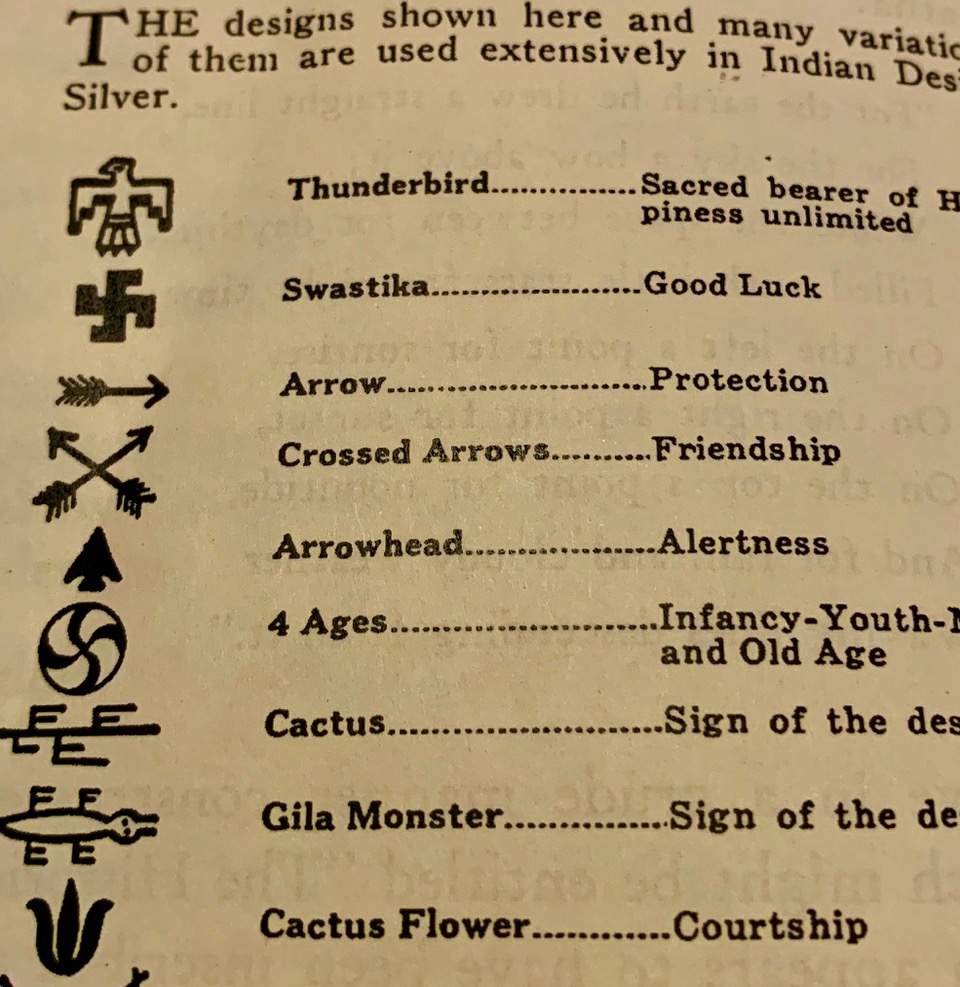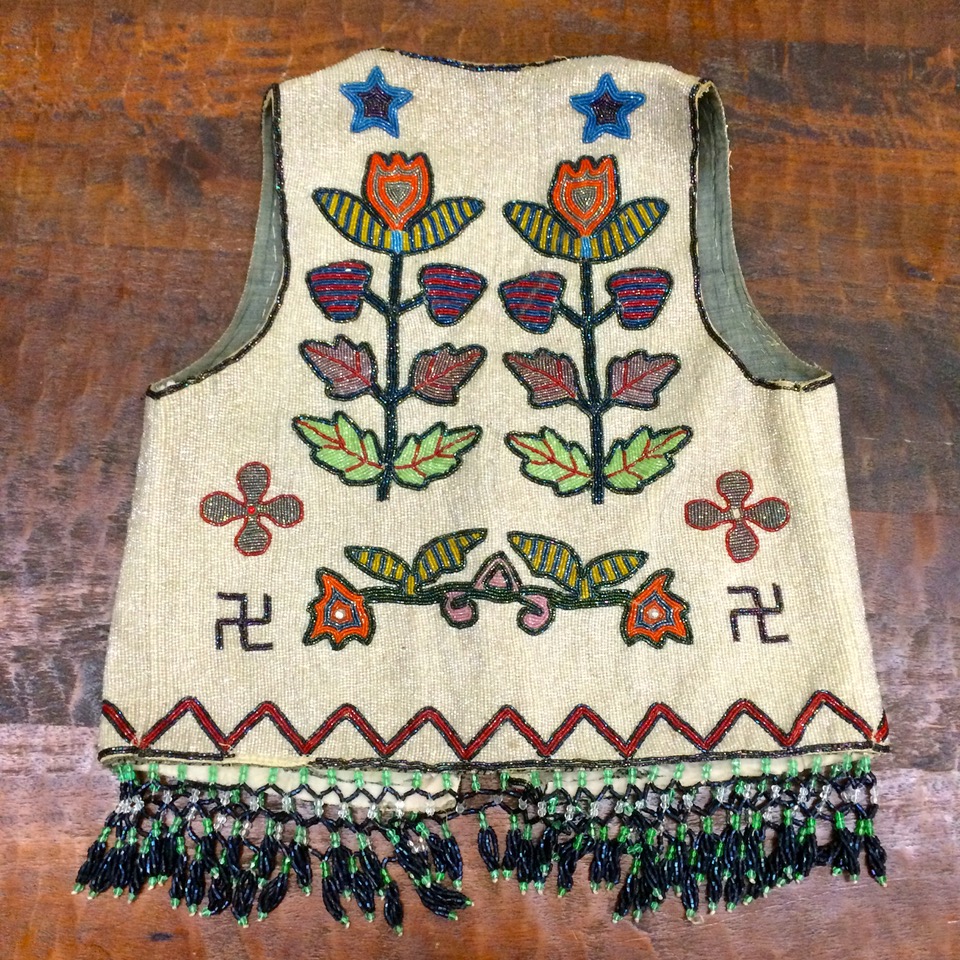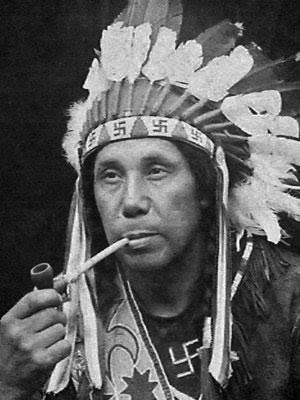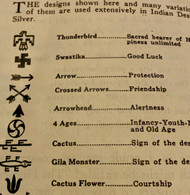Collector's Corner - History of the Swastika Symbol
Posted by Jim Olson on Aug 26th 2020
Throughout much of the modern world, the Swastika symbol represents Nazism and reminds us of Adolf Hitler—racism. But it was not always this way. Prior to WWII, it was a globally recognized symbol. Its meaning had nothing to do with Nazi Germany except in the few years leading up to and including the war. Before that, it was associated with good luck.
The symbol has a long history dating back to prehistoric times. In the Americas, variations of it have been found in excavations of Mound-builder and Mississippian era sites in the mid-west, while further south the ancient Aztecs were said to also use the symbol. By the early 1900s, several Southwestern and Plains Native American tribes were using it on crafts built for their own use and for that of the commercial tourist markets.
According to Wikipedia, the earliest known use of the symbol may date back as far as 10,000 BC. They report, “it was found on a late Paleolithic figurine of a bird, carved from mammoth ivory, found in the Ukraine.” The symbol dates to 6,000 BC in Bulgaria and 3,000 BC on the Indian Subcontinent according to archeological findings. It has been found in prehistoric sites in Africa, China and Europe as well. It seems the Swastika symbol, or variations of it, were used in many parts of the world during ancient times.
In about 1870, German archeologist Heinrich Schliemann found objects bearing the Swastika in the ruins of what was believed to be the lost city of Troy. Some credit this discovery, and subsequent publications about it, as a catalyst for the resurgence in the use of the Swastika in modern times.The Swastika gained popularity in the West during the late 1800s and was widely used. It remained popular through the 1920s, until use of it waned in the 1930s. It had increasingly became associated with Nazism by then.

In the American West, it was on many Cowboy and Native American items during the time period mentioned above. Jewelry, saddles, textiles, baskets, bridles, spurs, pokers chips and a large variety of other items were decorated with it— it even appeared on road signs in Arizona. To the Americans, it was touted as an “Indian Good Luck” symbol. Who came up with that idea? I don’t think we will ever know for sure. Although it had been used as a good luck symbol worldwide in the past, it was probably a trader somewhere who encouraged the modern day Natives to decorate their crafts with “Indian looking” and popular symbols of the day so he could sell their wares to the tourists and have a story to go with them.

In the late 1930s, Native Americans collaborated in agreement with each other to quit using the symbol on their crafts for sale in light of what was going on with the Nazis. Those who made other Western items such as bits, spurs, saddles and the like also quit using it. During the WWII years and thereafter, many items bearing the symbol were destroyed due to the Nazi stigmata which had become associated with it. Since so many of those items were destroyed however, it became increasingly harder to find authentic examples them. As we get further away from the war years however, and people start to look past the relatively few years it was used by the Nazis, it has become more acceptable to collect those types of antiques once again.

For many Western Americana collectors, it is desirable to collect objects with the symbol on them. A plus often cited is that it helps to determine the age of an item (pre-WWII). Most Americana collectibles found with the symbol adorning them date to between 1890 and 1930. It is a novelty among some collectors to search out these items due to their rarity.
However, this has also led to a resurgence in the use of it on crafts and jewelry once again. Until recent years, if you found a Native or Western Americana type of object with a Swastika on it, there was a high degree of probability it was made between the late 1800s and early 1930s. But since authentic items are getting harder to find because more collectors are seeking them out, now-a-days, you will also see it on modern made “retro style” items as well.
Where did the name come from?
The word Swastika is said to have Sanskrit origins and can be found in writings dating back to 500 BC. It roughly translates into: to be good; to be well; or auspicious. There are different words for it around the globe, but Swastika is by far the most common. In the Western United States, a common contemporary term for it on Americana is “Whirling Logs.”
I believe the term “Whirling Logs” is something used more after WWII to give it a symbolism more closely associated with a Native American sounding theme—setting it apart from the word Swastika. Prior to the war, you would rarely (if ever) see the term “Whirling Logs” appear in literature or brochures promoting Western Americana or Native crafts. The word Swastika however does appear in such ads or sometimes the phrase, “Indian Good Luck Symbol” was used. After WWII however, using the word Swastika on an item for sale would have been a difficult sell. Therefore, another term such as “Whirling Logs” sounded more acceptable. So “Whirling Logs” is now the popular label for the symbol on Americana.
How is it properly drawn?
Variations of the Swastika appear all over the globe from ancient times to now. It can be left or right facing, be squared off, hooked, offset, etc.. In antique Americana and Native American items, it is found both left and right facing and is usually squared off. In Nazi Germany however, it was always squared off, right facing and stood on end. All authentic Nazi items bearing a Swastika are marked this way. They never drew it using any of the other variations. In Western Americana however, there is no right or wrong way for it to appear and you will see it in several different forms on those items.
Are you a racist if you collect items with the symbol on them?
In most of the world and throughout the better part of history the symbol has been associated with good luck or something close to that. The Germans however used it to symbolize nationalistic pride and Arian supremacy. But the Nazi German use of the Swastika reigned for a mere 25 years or so out of the entire existence of the symbol which goes back thousands of years. So if you are a collector or dealer who seeks to educate the world about the true meaning of it, or perhaps you simply find it a novelty to collect because of its colorful history, that does not make you a racist. Far from it. However there are still a few extreme individuals out there who use it to symbolize some sort of supremacy.So really it boils down to how think about it and how you use it that matters. Therein lies the difference between a genuine collector and a wanna-be Nazi.
Jim Olson © 2020

